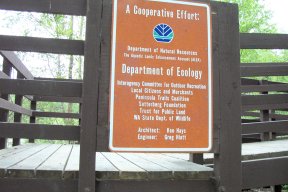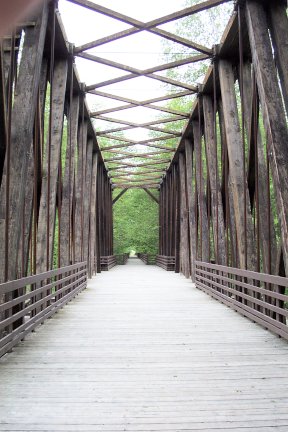From the North Olympic Peninsula:
The Olympic Discovery Trail – helping create 'livable'
communities at taxpayers' expense
By Sue Forde, Citizen Review Online
www.citizenreviewonline.org
Clallam County, WA – May 23, 2002 –
A fresh outcry has been heard lately as a new group of landowners is
being pinpointed for the North Olympic Trail across or near their properties. Near
Port Angeles, approximately 45 residents made an uproar when presented with
county designs near their property. The
neighbors petitioned county commissioners to reconsider the trail location.
It's going through anyway.
In Sequim, residents on several streets in the northeast
part of the city have opposed trail proposals for their neighborhoods.
The city moved forward with accepting a bid for the trail, “partly
because of pressure from the state DOT [Department of Transportation] officials
on use of the grant money”.
Citizens along Sequim Bay Road just east of Sequim aren’t
happy either. They don’t want a
trail crossing their property or even being close to it. It’s going there, too.
This isn’t the first time that people have had to accept
the trail near their property despite their protests against it.
Over the years, as the trail has been pieced together, there have been
other protests, to no avail.
If the people near and on the trail are against it, then
why would it go forward? one may ask.
The Clallam County Olympic Discovery Trail mandated under
the Washington State Trail Plan, was established to “develop alternatives to
the use of single occupancy vehicles, such as bicycle commuting, carpools, and
transit.”
One step up the ladder takes us to the National Trails
System Act of 1968 (Trails Act), which Congress enacted to establish a
nationwide system of nature trails.
Later legislation brought us the rails-to-trails scheme,
which involved “public” (read government) acquisition of property for
“public purposes” – including recreational purposes. The Trails Act
Amendments directed the Department of Transportation (DOT), and the Department
of the Interior (DOI) to “encourage state and local agencies and private
interest to establish trails where appropriate.”
Incorporated into these two agencies’ provisions is the concept of
“sustainability”, or “livable” communities.
So, across the nation, trails like those in our area have been built and
are continuing to grow, as the nationwide network comes together.
| The
Olympic Discovery Trail is
planned to run from Port Townsend in the East to the Pacific Coast in the West.
Small portions have been completed, including a few miles near Port Townsend, a
few miles near Sequim, and around 20 miles near and in Port Angeles. In
a time when roads are falling into disrepair, and we are told there is a
shortage of funds for transportation, most of the funding for the trails comes
from the federal Department
of Transportation., from the National Scenic Byway Program and the
Washington State Department of Transportation.
Construction funds were committed through the Interstate Surface
Transportation Efficiency Act (ISTEA) program (80%) and Clallam County (20%).
The County maintains a Paths and Trails Fund as required by state law,
which is used to cover the County’s share.
Trails
cost billions in taxpayers’ dollars (your dollars)
The
funding for this year alone for our little county, from only one of the federal
and state agencies allocated to the Olympic Discovery Trail is $544,910,
designated to construct the last trail segment between Port Angeles and Sequim.
The federal Recreational
Trails Program is an assistance program of the U.S. Department of
Transportation's Federal Highway Administration (FHWA), which will be funding $50
million per year for easement buyouts, state administrative costs, and
maintenance.
In
1996, the Olympic Discovery Trail got a $250,000 Heritage Corridors Grant.
Project cost for 3.5 miles of the trail in 1996 was $474,000– a cost of
$135,428.00 per mile. While
city and county leaders tout that the trail will bring in tourists and money to
the economy, 8 years later, walking the trail reveals that only a few people use
it regularly. Apparently the hope
has not panned out, yet the trail continues to be built.
|
|


Shown here is a portion of the Olympic Discovery Trail at the Dungeness
Railroad Bridge Park near Sequim, WA.
-Photo by Sue Forde
|
Since Congress introduced TE
in 1991, [Transportation Equity Act for the 21st Century] more than $2.4 billion has been invested nationwide in
facilities for walking and bicycling, historic preservation, scenic
beautification, land acquisition and environmental mitigation. In 1998, the TE
program was reauthorized in the Transportation Equity Act for the 21st Century
(TEA-21), ensuring that through 2003, about $620 million in annual funds will be
made available to state transportation agencies for these types of projects.
TEA-21 will be reauthorized in 2003 and Rails-to-Trails Conservancy is launching
a major effort in the spring of 2002 to make sure this important legislation is
renewed.
Special Interests play a role in the local trail
The trails in Clallam County fall under the comprehensive
plans of the state-mandated, Growth
Management Act (GMA). In 1994, the
county planning commission, consisting of Paul McHugh (now a Sequim city
councilman), Steve Tharinger (now a county commissioner) and Alan Merson,
incorporated the trail as one of the items to be accomplished to make the area
more “livable.” Tharinger’s
wife, Yvonne Yakota, currently serves on the board for the Peninsula
Trails Coalition. In Sequim,
one of the local trail sponsors, Primo Construction, just received the contract
to connect Carrie Blake Park to John Wayne Marina with a bid of $725,114.53.
A state grant from the DOT (taxpayers’ money) will cover the tab.
The potential for crime on trails
One of the arguments locals have expressed is the high
possibility for criminal activities on an un-policed trail, where several
segments are fairly remote. One
young mother in Port Angeles expressed the views of many when she said she was
concerned the trail and the walkers, bicyclists and horseback riders who would
use it would destroy the safety and rural atmosphere of her neighborhood.
She and the other homeowners seem to have good cause for concern, when
you read newspaper clippings about the crime on trails in other areas.
Headlines I’ve seen include: “Another attempted rape on
the Spokane, Washington trail”, “Police seek leads in assault of teen on
interurban trail”, “Police seek suspects of 4 Carmel burglaries – all near
the Monon Trail”; “Another senseless crime on a bike trail around Seattle,
WA”, and so on. A good place to
research this for yourself is NARPO [National
Association of Reversionary Property Owners]. Unanswered questions on the North Olympic Peninsula include
who will police the trail, and who is liable for people’s endangerment.
The security question has been around since the trails
began here a number of years ago. In a presentation at that time, Senator Patty
Murray’s Mike Egan came to address the trail issue, including land
acquisitions. Claire Rogers, then
head of the Peninsula Trails Coalition, who also spoke, couldn’t answer
questions about enforcement. She
stated in an interview that enforcement like “ski patrols” could possibly be
used.
The Concept – Sustainable Development in the Making
The Rails-to-Trails national movement, of which the North
Olympic Peninsula, is a part, began over 25 years ago, according to the Rails-to-Trails
Conservancy (RTC), a nongovernmental organization (NGO).
While the idea of trails may sound good, in fact, it’s
one more move toward “sustainable” communities.
One of the goals of sustainable development is to get people out of their
cars and into mass transit or other methods of transportation (ie bicycles or
walking), after the manner of Europe. In the Trail Information Packet for the Olympic Discovery
Trail, the goal is stated to “serve recreation and transportation needs of
the community.”
On Oct. 28, 1996, DOT representative Dan Burden from
Florida was invited to come and promote the concept of trails in Sequim.
He gave a slide show presentation, explaining “sustainable” land use.
He has been Florida’s Pedestrian/Bicycle Coordinator for more than 20
years. He discussed the importance
of the “sustainable land use and sustainable towns.” He stated, “Sometimes
it takes forceful measures to bring needed change.”
In a brochure he produced, he discusses the importance of
“sustainable land use and sustainable towns.”
The problem, he states, is a result of “planned isolation.”
It is difficult to walk or bicycle to any place…churches, parks, stores
– everything is isolated. Everyone
drives, he continued, and vast parking lots take up the land.
In the alternate scene, based on “new urbanism and
traditional design”, anyone can walk or bicycle anywhere.
He proposed taking our towns back to walking-scale size.
“Want a sustainable town?” he asks.
“Developers build to the form that the community sets forth as the town
genetic code. Change the code,”
he says.
Burden proposed more density in housing and apartments to
make the town more “walking friendly” and less dependent upon the
automobile. This increases land
efficiency and is sustainable, he asserted.
Neighborhoods can be reclaimed, he says by providing trails
and greenways. Residents can walk,
ride bikes and otherwise travel to school, into other neighborhoods, and “feel
connected to their community.” (In
a community of a high percentage of retirees, one wonders if he plans to include
wheelchairs in his scenario.)
‘Out of your private cars, people!’
Sorry, folks, private cars are not sustainable!
One of the reasons the trail system is being developed is to get people
out of their cars. They’re not
“sustainable.” The very
dimensions of cars “make them less than sustainable,” says one report.
Mass transit is touted as another necessary solution to the
“sustainability” problem. The
same report states that “while mass transit seldom affords the freedom or
individuality of the private automobile…advocates of sustainability feel that
mass transit systems should be seen as one of the necessary infrastructure
elements found in modern society, like sewer systems, roads and overhead
wires.” Bicycles and walking, on
the other hand, are considered to be very sustainable.
A local
Comprehensive Plan offers an example of the type of wording throughout many of
the regional documents: “Non-motorized travel should be promoted within the
Sequim-Dungeness area for multi-purpose recreation and transportation trails for
users of all abilities.
The Rails to Trails Conservancy, in its “Aid
to Transportation Planning under ISTEA,” says “Because rail-trails
encourage and facilitate non-motorized transportation, they lessen our
dependence on cars and foreign oil, and benefit communities by lessening air and
water pollution. Research indicates
that if safe facilities are provided, bicycle transportation use would increase
from 5 percent to 13 percent of total trips…Bicycling and walking may never
meet all of the transportation needs currently met by motor vehicles, but in
combination with transit, intercity buses, and trains, rail-trails can provide a
viable alternative for many trips now taken by single-occupant autos.” They add that it’s “sustainable in the long-term.”
Future Transportation Corridors
Federal government agencies have a “vision” for our
future. They want us living in
“sustainable” – or as I see it phrased more frequently now, “livable”
communities. That vision comes from
even higher – the United Nations, with its many documents that talk about the
subject, which began with the Rio Summit in 1992. (See
UN Mountains and UN Sustainability). The provisions in the documents
for the trails include “future transportation corridors” in their vision.
We’ll have to wait and see how those play out.
It seems that local people should decide upon and provide for their own
local standards about what’s “livable” in their own communities.
We’re faced with a “think globally, act locally” mantra that will
take much to overcome. How far
we’ve gone from the original freedoms we enjoyed as a result of the sacrifices
of many generations before. One
wonders if it can be regained.
Is this happening in your community?

